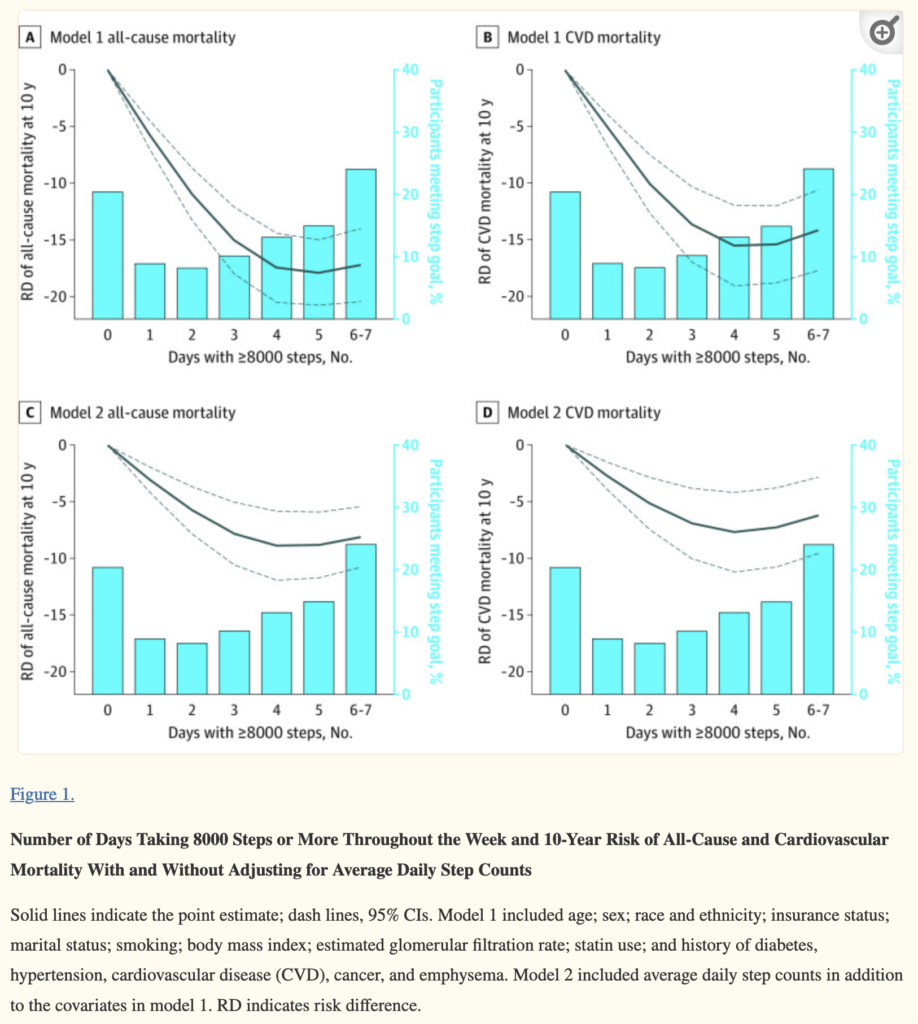
If you want to help your patients extend their life expectancies, tell them to take a hike!
People who walk at least 8,000 steps per day for two or more days each week have significantly lower all-cause cardiovascular mortality rates 10 years later.
That’s the conclusion of an in-depth analysis of accelerometer data from 3,101 ethnically diverse US adults who participated in the National Health and Nutrition Examination Surveys (NHANES) in 2005-2006 (Inoue K, et al. JAMA Network. 2023).
A collaborative research team based at the UCLA Geffen School of Medicine, and the Kyoto University Graduate School of Medicine, divided the cohort into three groups based on how often they reached the 8,000 daily steps threshold (0, 1-2 times per week, and 3-7 times per week).
They then screened the National Death Index through the year 2019 to determine which of the NHANES study subjects had died, and from what causes.
The cohort ranged in age from 32 to 69 years (mean 50.5 years) at the time their walking patterns were tracked. The group was more or less evenly split between women and men, and included 21.5% Black and 23.7% Hispanic participants.
The 4 Mile Threshold
Of the total, 532 (17.2%) took 8,000 or more steps per day on 1-2 days per week; 1,937 people (62.3%) hit that threshold at least three times weekly. Eight thousand steps equals roughly 4 miles, based on an average stride length of 2.1 to 2.5 feet.
During the 10-year follow-up period, there were 439 (14.2%) deaths from all causes and 148 (5.3%) deaths related to cardiovascular disease among the study participants.
After adjusting for confounding variables such as age, ethnicity, marital status, smoking status, and pre-existing disease diagnoses, the researchers found that those who met the 8,000-step criterion on one to two days per week had a 14.9% reduction in all-cause mortality compared with the subset that never met the 8,000-step threshold during the tracking period.
For those who walked 8,000 steps on 3 or more days per week, the mortality reduction was 16.5% relative to those who never met the that 8,000-step cutpoint.
The mortality figures were based on calculation of adjusted risk differences (aRDs).

The investigators note that one aim of the study was to determine if there is a dose-response pattern in the effects of walking on health and wellbeing. The numbers suggest that this is the case.
A “Dose-Response” Pattern
“The dose-response association for both all-cause and cardiovascular mortality risk was curvilinear; the protective association plateaued at 3 days per week,” they write, adding that “different thresholds for the number of daily steps between 6,000 and 10,000 yielded similar results.”
This new study confirms the conclusion of a 2022 metanalysis of 15 international populations which showed that mortality declines steadily in relationship to increasing numbers of daily steps, up to 8,000 steps per day (Paluch AE, et al. Lancet Public Health. 2022)
Number of daily steps is an easy proxy for overall physical activity. A worldwide study of smartphone accelerometer data gathered from more than 717,000 individuals, and representing 68 million aggregate days of activity, showed that Americans average just 4,800 steps per day (Althoff T, et al. Nature. 2017). That’s far below the 8,000-step threshold that has consistently been associated with health benefits.
In her critique of the new UCLA-Kyoto University study for DynaMed, Elham Razmpoosh, PhD, a postdoctoral fellow at McMaster University, pointed out two major flaws that compromise the strength of its conclusions.
First, is the fact that the patients who repeatedly hit the 8,000-step threshold tended to be younger and healthier than those who did not, which suggests that frequency of walking is a reflection of overall health as much as it is a causal factor.
Second, the researchers quantified mortality differences in terms of adjusted risk differences which only indicate the absolute differences in risk between the frequent walkers and non-walkers. Razmpoosh argues that hazard ratios would have been a more appropriate statistic because these calculations account for time-to-event (in this case death) whereas aRDs do not.
Walking = Health
Bearing in mind these caveats, the Inoue study does underscore the connection between walking and health, and it indicates clearly that people need not engage in strenuous workouts in order to obtain the physiological benefits of physical activity.
Inoue and colleagues point out that inactivity is a major public health problem, one that contributes to an estimated 3.2 million deaths and $54 billion in healthcare costs each year (Ding D, et al. Lancet. 2016)
As most clinicians know all-too-well, it can be very difficult to get patients—especially older people and those already plagued by metabolic dysregulation—to exercise regularly. Walking is an easy, inexpensive, accessible and often enjoyable way to start becoming more active.
“For adults who face difficulties in exercising regularly, achieving the recommended daily steps only a couple days a week may have meaningful health benefits,” Inoue and colleagues conclude.
END







